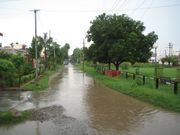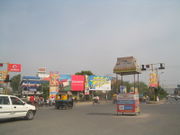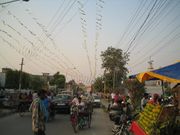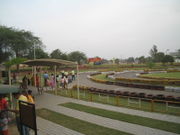Jalandhar
| Jalandhar | |
| — city — | |
|
|
|
| Coordinates | |
| Country | |
| State | Punjab |
| District(s) | Jalandhar |
| Divisional Commissioner | S. R. Ladhar |
| Population | 903 491[1] (2010[update]) |
| Time zone | IST (UTC+5:30) |
| Area |
• 228 metres (748 ft) |
Jalandhar (Punjabi: ਜਲੰਧਰ, Hindi: जलंधर), is a city in Jalandhar District in the state of Punjab, India. In Hindu mythology, Jalandhara was the eponymous kingdom of a devil in Satyuga. It was also known as Prasthala at the time of Mahabharta and it was also known as Jullundur in British times.
Contents |
History


Jalandhar along with Multan is the oldest surviving city of the Trigarta Empire (Punjab region) of Katoch Rulers, with reference in history as far back as A.D. 100.[2] The Jalandhar Doab (the region surrounding the city between Beas and Sutlej rivers) also marked the eastern most territory of the empire of Alexander the Great. He erected giant altars in this area to mark the eastern most extent of his empire and also founded a city named Alexandria in the vicinity and left many Macedonian veterans there.
In the 7th Century, when the famous Chinese traveller and pilgrim Hiuen Tsang visited India during the reign of Harsha Vardhana, the Kingdom of Jalandhara or Trigarta was under the rule of Raja Utito (whom Alexender Cunningham identifies with the Rajput Raja Attar Chand of the Katoch dynasty). The kingdom was said to have extended 167 miles (269 km) from east to west and 133 miles (214 km) from north to south, thus including the hill states of Chamba, Mandi and Suket (Himachal Pradesh) and Satadru or Sirhind in the plains. The city proper of Jalandhar was, when visited by Hiuen Tsiang, a large city, miles in circuit, and functioned as the capital of a Rajput kingdom.[3] Raja Utito was a tributary of Harsh Vardhana. The Rajput Rajas appear to have continued to rule over the country right up to the 12th century, with occasional interruptions, but their capital was Jalandhar and Kangra formed an important stronghold.
According to the Chinese pilgrim Fa Hien, who traveled India between 399 and 411 C.E., there were a great many Viharas of Buddhism in India. In the Jalandhar Doab, there were as many as 50 Viharas of Buddhism. The Buddhist religion was adopted by a large number of people. As per some historians and scholars the fourth Buddhist Council out of total six Buddhist Councils took place in Jalandhar in the first century AD during the reign of King Kanishka. The fourth council of Mahayana Buddhism took place here, and placed Buddha as a God at the council.[4]
Jalandhar became the seat of Nath movement from 8th to 10th century AD, one of its greatest saint was Jalandhar Nath, whose samadhi later became the site of the existing shrine of Imam Nasir-ud-din Chishti in the fifteenth century.[5] From the later half of the tenth century up to AD 1019, the district was included in the Shahi Kingdom of the Punjab and Jalandhar was an important city in the region. In about 1188 it fell to the control of Ibrahim Shah of Ghor.[2] Under the Mughals Jalandhar was the capital of a sarkar.[3]
In 1758 Maharaja Ghamand Chand of the Katoch dynasty was made the (first ever Rajput) Nizam of Jalandhar by the Durranis. Many Rajputs lived in and around the surrounding areas of Jalandhar before the partition in 1947. With the partition of the country, many like the Manj and Rawal Rajputs went to settle in the Pakistan side of the Punjab, whilst some went to other countries.
Jalandhar was captured by the Sikhs in 1757 and captured by the Faizullahpuria confederacy in 1766. Ranjit Singh annexed it in 1811, and in 1846 Jalandhar became the headquarters of the territory acquired by the British after the first First Anglo-Sikh Wars.[3] During British rule Jalandhar became the headquarters, of the Division and District of the same name. According to the 1901 census, the population of the town was 67,535 of whom 14,715 were Hindus, 40,081 Muslim, 901 Sikhs, and 1,543 Christians.[3] In 1947 with the independence and partition of India the Muslim population left for Pakistan while Hindus and Sikhs arrived from the other direction.[6]
Geography
The city has a humid subtropical climate with cool winters and hot summers. Summers last from April To June and winters from November to February. Temperatures in summer vary from average highs of around 48 degrees Celsius to average lows of around 25 degrees Celsius. Winter temperatures vary from highs of 19 degrees Celsius to lows of -5 degrees Celsius. The climate is on the whole dry except during the brief south-west monsoon season during July-August. The average annual rainfall is about 70 cm.
Economy

Jalandhar is famous for hospitals, having maximum hospitals in Asia.Some famous hospitals are Thind Eye Hospital,Patel Hospital,Tagore Hospital,Oxford Hospital,Pruthi Hospital,Guru Nanak Mission Hospital,Ruby Hospital,Ghai Hospital etc.Although every hospital has its own identity,but Thind Eye Hospital is on world map for its Lasik treatments. Jalandhar is also the world's biggest manufacturer of leather tool pouches and aprons with major American and European customers buying from factories in Jalandhar.It is the biggest supplier of sports material in the country. Jalandhar was a hub of the Gandhi government's green revolution of India in early 60s. Dr. Dilbag Singh Athwal, world renowned scientist in plant breeding, developed India's first high yield wheat Kalyan. The wheat he name afer his native village Kalyanpur 6 miles (9.7 km) southwest of city of Jalandhar. Later Dr. Athwal headed International Rice Research Institute, International Agricultural Development Service etc. Dr. Athwal took early retirement from his position as senior vice president Rockefeller Institute. The village Kalyanpur (now part of Jalandhar city) have produced prominent scientist including Dr. Raghbir Singh, Dr. Rajbir Kaur, Dr. Iqbal Singh Athwal. Jalandhar is also quite known for its electrical goods industry. Manufacturers like Hazel India,Standard Switchgears and Apex Electricals, located in Jalandhar. International sports market is situated in Jalandhar. Major Sports brands like BAS Vampire, Bhaseen's Baspo, JJ Jonex, Syndicate Sports etc., comes from this part of the world.
Demographics
The first language of most people in the city is Punjabi. The World Panjabi Meeting in 2007 was held in Jalandhar, and attendees noted the Panjabi language was losing its viability[7]. However, many in the Panjab exhibit linguistic pride, and some scholars have opinion that Panjabi may actually be gaining popularity as an indigenous medium of decolonization[8]. Since English is taught in Jalandhar schools from the first grade, it has been gaining in popularity in the city as well, and there has been an explosion in English language education in the state[9].
According to the 1991 census, the predominant religions of Jalandhar city are Hinduism (54.54%) and Sikhism (45.46%). Other religions make up around 2.17% of the population. The city is the seat of the Roman Catholic Diocese of Jullundur.
Media
The city is the media hub of the region having the regional headquarters of Newspapers, National Television and Radio stations.
- Daily Nawan Zamana
- Rozana Ajit (Daily Ajit)
- Akali Patrika
- Amar Ujala
- Dainik Jagran
- Dainik Bhaskar
- Punjab Kesri
- Jagbani
Education
Jalandhar Cantonment



Construction on Jalandhar Cantonment began in 1848. It is notable not only for its age, as it among the oldest cantonments in the country, but also for its proximity to Pakistan. It figured in the 1920 Connaught Rangers mutiny when Irish soldiers replaced the Union Flag with the Irish Republic's flag.[10]
Notable people
- Bashir al-Najafi al-Jalandhari, one of the few grand ayatollahs of the Iraqi Shias
- Diwan Bhai Abdul Hamid, chief minister of the princely state of Kapurthala
- Hafeez Jullundhri, poet, who wrote the lyrics for the National Anthem of Pakistan
- Lawrence Durrell, writer, born in Jalandhar
- Bapu Sarup Singh, freedom fighter and ex-minister of the Punjab government
- Dr Jaswant Singh Thind,world fame Eye Surgeon.
- Kundan Lal Saigal, Bollywood actor and singer
- Baba Kashmira Singh, religious leader
- Jagjit Singh, ghazal singer who studied in DAV College, Jalandhar, where his room is still preserved
- The Great Khali (Dalip Singh Rana), professional wrestler with World Wrestling Entertainment
- Yash Chopra, Bollywood director and writer
- Paul Nischal, first Indian candidate for the Conservative Party (UK)
- Hans Raj Hans, Punjabi singer
- Swraj Paul, first Indian member of the British House of Lords
- Remi Kaler, also known as Remi Clair, Canadian actor
- Ranbir Singh Kanwar, Director, Sugarcane Research Station, who revolutionized sugarcane research during the green revolution
- Kartar Singh, Wresslar
- Balbir Singh, Sr., Olympian, hockey player
- Gurdev Singh Kullar, Olympian, hockey player, originally from Sansarpur
- Darshan Singh, Olympian, hockey player, originally from Sansarpur
- Ajit Pal Singh, Olympian, hockey player
- Surjit Singh, Olympian, hockey player
- Pargat Singh, Olympian, hockey player
- Dharam Singh Uppal, international athlete
- Inder Kumar Gujral, former Prime Minister of India
- Dr Ranbir Singh, Medical Suptt. civil Hospital
- Dr Parminder Singh Thind famous eye consultant
- Sunil Dutt, Bollywood Actor
- General Muhammad Zia-ul-Haq, sixth President of Pakistan & Chief of the Pakistan Army
- Dr C S Pruthi, famous physian.
- Dr Chopra,Medical specialist
- Harbhajan Singh, member of Indian national cricket team
- Wasim Sajjad, served as acting President of Pakistan twice
- Mian Mohammed Sharif, former Surveyor General of Pakistan
- Lala Amarnath, famous Indian cricketer
- Chaudhry Muhammad Ali, fourth Prime Minister of Pakistan
- Swami Shraddhanand, educationist and Arya Samaj missionary
- Wazir Ali, prominent figure in early Indian cricket
- R. Paul Dhillon, Indo-Canadian journalist
- Ujjal Dosanjh, Indo-Canadian lawyer and politician
- Sukhbir, Bhangra singer
- Arun Shourie, journalist, author and politician
- Sheikh Anwarul Haq, ninth Chief Justice of Pakistan
- Agha Sadiq, Pakistani writer and poet
- Apache Indian, reggae singer
- Karan Kundra, TV actor
- Kapil Sibal, politician and lawyer
Villages around Jalandhar
Sansarpur, Talhan, Salempur Masanda, Parasrampur
References
- ↑ census of 2001 via archive.org
- ↑ 2.0 2.1 "tourism". National Informatics Centre. http://jalandhar.nic.in/html/tourism.htm. Retrieved 2009-04-01.
- ↑ 3.0 3.1 3.2 3.3 Jullundur Town - Imperial Gazetteer of India, v. 14, p. 231.
- ↑ Hugh Tinker (1966). South Asia: A Short History. Frederick A. Praeger.
- ↑ Jalandhar Govt. of Punjab (India) website
- ↑ Refuge in memories - Dawn
- ↑ World Panjabi Meeting kicks off; 27 Pak nationals fail to get visa Indian Express - February 16, 2007
- ↑ How English is helpful The Tribune, Chandigarh - May 24, 2005
- ↑ Mofussil towns as coaching hubs for higher education Times of India - July 12, 2005
- ↑ "Jalandhar Cantt". National Informatics Centre. http://jalandhar.nic.in/html/cities_towns_jalandhar_cantt.htm. Retrieved 2009-04-01.
External links
- Official website
- Paper about the Jalandhari presence in the UK, Centre for Applied South Asian Studies (CASAS)
|
||||||||

